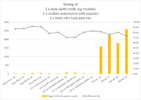v81
Member
Nope, the 3mA is with nothing connected to the HK3, no camera, no load, nothing at all.I thought that was camera powered down current, effectively the power used by the GPS module, low voltage cutoff was a lot less when I measured it...
edit- The 3mA above was from the screen of the lab supply, have re-run the test with the multimeter.
On mode, no load connected - 6.09mA
Cutoff mode, no load connected - 3.01mA
Top stuff.I reran my low voltage power cutoff tests with the VIOFO HK3 today. I tested all of the voltage selections (12.4/12.2/12.0/11.8) and all of them behaved the same.
I've reworked the video and in it I show a test run of the HK3 with it set to 12.4 volts for the cutoff voltage level.
I start off the test by powering up the dash camera by simulating a "car start" event. I then turned off the accessory power supply (ignition off) and the VIOFO A129 Pro camera would go into parking mode. After the A129 was in parking mode, I would reduce the voltage level provided by the power supply in multiple steps. I would test each voltage level for 120 seconds and then reduce the voltage again and wait again. When the voltage level was reduced to 0.1 volt below the HK3 configured value, the HK3 would cutoff power to the dash camera after a 95 to 100 second waiting period.
I've uploaded the updated video my YouTube channel.
The minute and a half is a long time, but given the nature of the intended scenario it's probably not bad at all.
Gives the camera every chance to run as long as possible without any transients or extended momentary sags crossing below the threshold.
Your testing method as described sounds spot on and your last video quality (picture, sound and content) was great, will watch the new one in a minute.
Sadly not heard from Viofo yet.
Might get dad to contact the seller, they might have a relationship with Viofo.
If anyone in Australia is reading this i'd love to get hands on additional units, working or not, for additional testing.
I suspect even working units have this terrible regulation, but would also like to test for efficiency as well.
Last edited:

